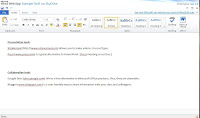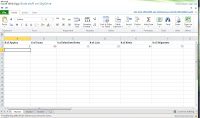DoInk (http://www.doink.com)
Creating a flash animation (swf file) used to be practically out of reach for many college students, until now. DoInk provides a user-friendly, cloud-based, free platform to create simple animations. One perfect use for these files is with Prezi. Now you can create moving words, shapes, people, images and have them imported into your Prezi presentation. These repeating animations can be quite effective at re-capturing or holding an audience’s attention. Another way to use this program is to create a form of kinetic typography, perfect for visualizing a short poem or haiku. Since you can create an account and an illustration in a typical class period, DoInk would provide a perfect class assignment. Once you create an illustration or animation, you can download it as a swf file, embed it in a website, or link to it. It took me about 10 minutes to create this animation below (just hit the play button):
questions by apostels, made at DoInk.com
odosketch (http://sketch.odopod.com/)
While Microsoft Paint and Google Drawing provide an easy way for students to create their own clip art for presentations and documents, the results are usually a little basic. Though these programs are helpful (Google Drawing even allows collaboration), they can really frustrate those who are more artistically inclined. Enter odosketch. This ingenious website provides users with a dozen or so pencils and colors and a sheet of paper (all digital of course). Once the illustration is drawn you can share the file on a website or blog via an embed code. The result is an eye-catching animation of the drawing in progress. If you are more interested in a standard, still-frame jpeg-like version of the drawing, just take a screen capture of the finished drawing and paste it into your document or PowerPoint. The site works wonderfully with touch pad computers. The best thing about this site is there is almost no learning curve. Check out this animation featured on the site to see the potential odosketch offers (refresh your browser if the drawing is already completed):
Shawn Apostel and Emily Bayma scour the Internet in search of the best, most useful websites to use with assignments, group projects, and creative inspiration. Shawn Apostel is the Instructional Technology Specialist at Bellarmine University and Emily Bayme is the Technology Associate at the Noel Studio for Academic Creativity.
Friday, September 23, 2011
Friday, September 16, 2011
Silver Lining: Cloud Storage for Easy Data Access
Dropbox (www.dropbox.com)
Dropbox is an easy-to-use, simple means of accessing your data anywhere. It's as easy as uploading it to your account on the website, or as easy to as dragging and dropping into a folder on your computer.Signing up for Dropbox gives you 2 gigs of storage free (or, if you accept a friend's referral, 5) with paid options to increase your storage. Your data is available wherever you have an internet connection (through the website) or wherever you download the Dropbox program or app. I have a work Dropbox account that I access through the website, and a personal one that lets me see my files on my desktop at work and my desktop at home, and additionally on my iPod Touch. When you use the program or app, your data is available whether or not you have an internet connection, making it easy to access your data when you need it most. It also offers functionality to share files with other users, making it great for collaboration of both files and folders.
Skydrive (http://skydrive.live.com)
Skydrive is part of Windows Live, which controls many old and new Microsoft services (including Hotmail and Xbox Live). The most useful benefit to this service is that, if you're already part of Windows Live, it's the same username and password to access your Skydrive as it is to access your Hotmail. Skydrive at its most basic is a combination of both Google Docs and Dropbox, offering simple but effective versions of Microsoft's own Office products in a web browser to create new documents, spreadsheets, and presentations while also offering 25 gigs of free file storage (with a 100mb upload limit per file). Skydrive offering the functionality of Microsoft Office is perhaps the greatest strength of this particular service. Many of the features are present and able to be used, and there is a built-in export feature to the current Office product.
Currently it supports Word, Excel, Powerpoint, and OneNote. Like Dropbox it offers sharing options to other users, or keeps your data private.
Dropbox is an easy-to-use, simple means of accessing your data anywhere. It's as easy as uploading it to your account on the website, or as easy to as dragging and dropping into a folder on your computer.Signing up for Dropbox gives you 2 gigs of storage free (or, if you accept a friend's referral, 5) with paid options to increase your storage. Your data is available wherever you have an internet connection (through the website) or wherever you download the Dropbox program or app. I have a work Dropbox account that I access through the website, and a personal one that lets me see my files on my desktop at work and my desktop at home, and additionally on my iPod Touch. When you use the program or app, your data is available whether or not you have an internet connection, making it easy to access your data when you need it most. It also offers functionality to share files with other users, making it great for collaboration of both files and folders.
Skydrive (http://skydrive.live.com)
Skydrive is part of Windows Live, which controls many old and new Microsoft services (including Hotmail and Xbox Live). The most useful benefit to this service is that, if you're already part of Windows Live, it's the same username and password to access your Skydrive as it is to access your Hotmail. Skydrive at its most basic is a combination of both Google Docs and Dropbox, offering simple but effective versions of Microsoft's own Office products in a web browser to create new documents, spreadsheets, and presentations while also offering 25 gigs of free file storage (with a 100mb upload limit per file). Skydrive offering the functionality of Microsoft Office is perhaps the greatest strength of this particular service. Many of the features are present and able to be used, and there is a built-in export feature to the current Office product.
Currently it supports Word, Excel, Powerpoint, and OneNote. Like Dropbox it offers sharing options to other users, or keeps your data private.
Friday, September 9, 2011
Publish, don't Perish: Create a Website in Minutes
Wix (http://www.wix.com/)
This easy to use website allows you to create Flash websites by simply typing and clicking on areas you want to modify and edit. To help you get started, Wix provides you with many free templates that are easy to customize. Once you select a template, you can alter the photographs, buttons, fonts, colors...just about anything by simply clicking on the area you want to change. The entire process is quite intuitive. You can save your progress as you edit the site, and, when you are done, select “publish”and go live. The url will begin with wix.com, but you can select your own url after that. Remember to think about search engine optimization when creating a site name. Shawn created this site and launched it in about an hour using a template for a coffee shop. Not too bad for someone who hasn’t worked with Flash in about two years. Wix allows you to move the entire page to your own personal website, but you’ll have to pay monthly for that service.
Google Sites (https://sites.google.com)
Create a simple website perfect for communicating with large groups of people using Google Sites. To begin you can select a template or create your own page from scratch. Again, like Wix, Google sites begin with the sites.google.com/site but you can choose your own url after that. One thing we really like about Google Sites is that you can have multiple editors for the same site, which is very handy if you are having a class design a website for a local non-profit. The entire class can edit and share the site with the client, and then the client can easily keep the site updated after the class is over. Using Google Sites is similar to using a document editing software like OpenOffice or Microsoft Word, so the learning curve is almost non-existent. It’s also easy to embed photos from your Picasa, YouTube, or Google Doc account. Not too bad for a free website.
This easy to use website allows you to create Flash websites by simply typing and clicking on areas you want to modify and edit. To help you get started, Wix provides you with many free templates that are easy to customize. Once you select a template, you can alter the photographs, buttons, fonts, colors...just about anything by simply clicking on the area you want to change. The entire process is quite intuitive. You can save your progress as you edit the site, and, when you are done, select “publish”and go live. The url will begin with wix.com, but you can select your own url after that. Remember to think about search engine optimization when creating a site name. Shawn created this site and launched it in about an hour using a template for a coffee shop. Not too bad for someone who hasn’t worked with Flash in about two years. Wix allows you to move the entire page to your own personal website, but you’ll have to pay monthly for that service.
Google Sites (https://sites.google.com)
Create a simple website perfect for communicating with large groups of people using Google Sites. To begin you can select a template or create your own page from scratch. Again, like Wix, Google sites begin with the sites.google.com/site but you can choose your own url after that. One thing we really like about Google Sites is that you can have multiple editors for the same site, which is very handy if you are having a class design a website for a local non-profit. The entire class can edit and share the site with the client, and then the client can easily keep the site updated after the class is over. Using Google Sites is similar to using a document editing software like OpenOffice or Microsoft Word, so the learning curve is almost non-existent. It’s also easy to embed photos from your Picasa, YouTube, or Google Doc account. Not too bad for a free website.
Subscribe to:
Posts (Atom)




